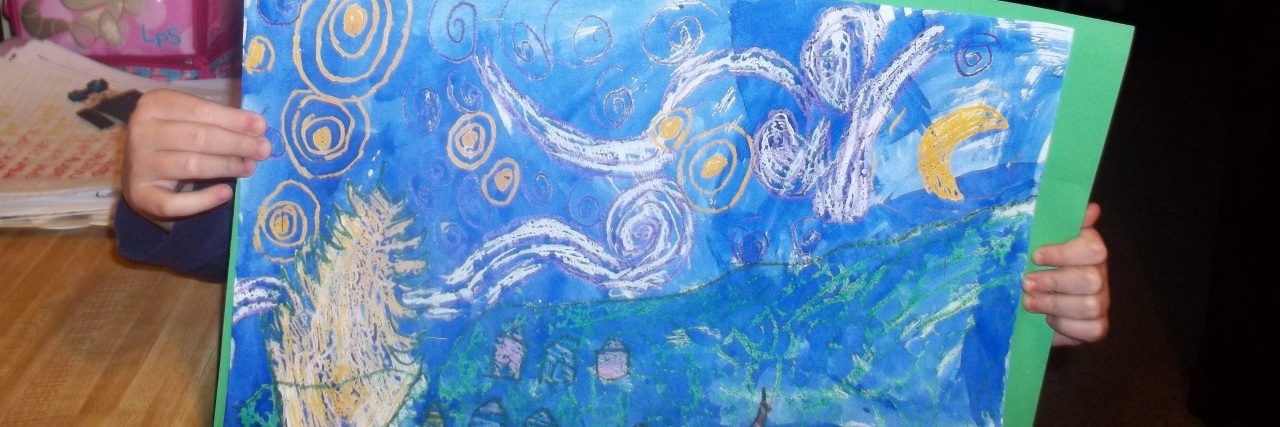Three years ago when my daughter was in second grade, her art class studied Vincent Van Gogh. I was very impressed with her description of his changing hues over time, the memory of Don McLean’s “Starry Night” tribute to Van Gogh remote in the background of my own thoughts.
One day, when I picked her up from school, she had this wonderful version she had made of his painting, which she had affixed to its matting quite uniquely and in a fashion I thought Vincent would have probably appreciated. A few weeks later at an open-house, we toured the school and one hallway had dozens of other second-grader’s renditions of this painting hanging side by side along the top of the hallway, all squarely matted with the same amount of edging all the way around. My daughter’s version was not being displayed with the others and I did not know why. I wondered if my daughter’s painting was too different. I wondered if other parents wouldn’t understand whatever artistic statement she may have been making?
That same year, her school helped us with a discovery. After asking my permission to test her to see if she qualified for special education support services, they determined that she did based on her scores from a variety of mental and physical tests. The day they asked me for permission to test her I attended a meeting in a room adjacent to the school office a half hour before school started. Her teacher, school psychologist and a couple special education teachers were there, then others started to arrive: her gym teacher, other teachers and specialists who had interacted with or observed her — and even the principal.
As they went around the table reviewing their notes with me, I began to see a pattern of traits they were describing that mirrored — to some extent — the TV character Max Braverman in “Parenthood” and I said, “This sounds a lot like aspergers.” They all looked at me, it seemed as if to see how I was handling that new revelation, and when it looked like I was maintaining my composure, the principal smiled and excused herself, each of the teachers and specialists followed suit until I was alone with the school psychologist and special education teachers. It wasn’t until I left the building that I realized they were there to offer me emotional support.
The following year, after finding and following several Facebook pages by parents of autistic children, I took my daughter to a neurologist for an official diagnosis, faxing her test results to his office the day before the first session. He met with us and asked to see the folder I brought with those test results. Flipping through the pages, he pointed to a chart of her IT scores. “Do you see that number? Only 1 percent of the people in the world can score higher than that. It’s her long-term memory.” I smiled to think that we would probably never meet any of those 1 percent, then laughed because I had just attended a conference to see an autistic speaker and her mother: Temple Grandin and Eustacia Cutler. I had purchased a book which Dr. Grandin autographed to my daughter titled “Thinking in Pictures.” Temple Grandin might likely score higher on that test.
I believe advocacy is born of necessity and is empowered by understanding, continuing education and outreach. And before I considered myself any kind of advocate, I had a long journey with my daughter. Reaching out to different support groups on Facebook, I learned from autistic adults who invited me to join other autism groups, some support groups and other groups more advocacy oriented. I began to see my daughter’s sensory issues and help her develop ideas for managing her sensory environment — from the clothes we bought her to requesting noise-reducing headsets at school. Her autism journey has known many challenges and difficulties while also showing incredible intellectual and artistic abilities.
I am humbled to be a part of her journey. And I have learned her perspective is beautifully different, even if at age 7 she might not find the words to explain why she formatted her picture in a particular way. She had studied Van Gogh and came to her own unique opinion on a question that she alone asked, “What would Vincent do?” She is her own advocate. I’m just a fellow sojourner in this strange land of learning and understanding and seeing the world in a new way.
We want to hear your story. Become a Mighty contributor here.

